California
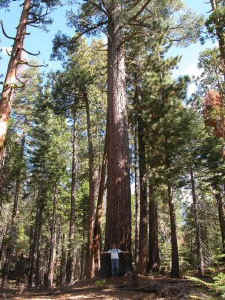
Pinus lambertiana, El Dorado National Forest, CA
- photo by Don Bertolette, Oct 2004
|
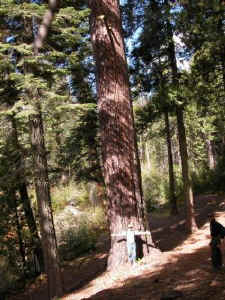 |
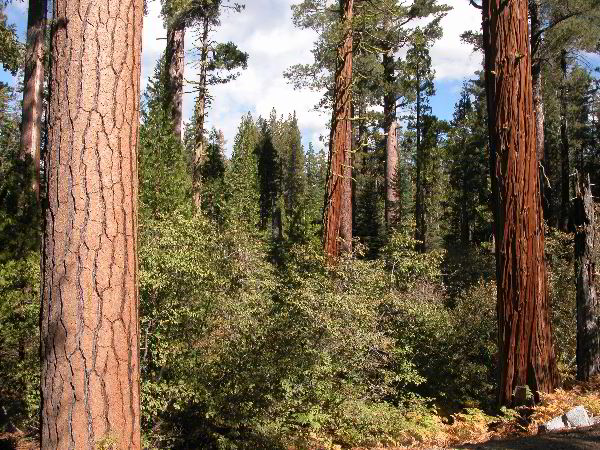
El Dorado National Forest Oct 2007 - photo by Don Bertolette
 California
California
On March 14, 2010 the Eastern Native Tree
Society and Western Native Tree Society switched from discussion
lists on Google Groups to a new discussion list in a Bulletin Board
format at:
http://www.ents-bbs.org/index.php Posts made since the
inception of the BBS on March 14, 2010 will be sorted and archived
on the BBS. Click on the link to go to the equivalent section on the
new BBS. This website will continue to serve as a front end for the
ENTS and WNTS groups. It will continue to serve as a repository of
older posts, and will serve as the host site for special projects
and features that are not well suited for a BBS format. Please visit
the BBS for the latest information and trip reports.
Discussions |
-
13,000 year old oak tree
[link] interesting article. Researchers from UC Davis and UC
Riverside say the 75-foot-wide Palmer's oak shrub has lived
about 13,000 years despite inhospitable surroundings,
regenerating itself with new shoots. Feb 24, 2010.
-
In California, a Scrub Oak Is an Old Pro at
Cloning WNTS, ENTS, I saw this report
on a California scrub oak ( Quercus palmeri) that might be of
interest to all of you: In California, a Scrub Oak Is an Old Pro
at Cloning By HENRY FOUNTAIN Published: January 4, 2010 In
Southern California, a place where most everything is new,
botanists have discovered something very old: a scrub oak that
has been cloning itself for at least 13,000 years....
more »
By Edward Frank -
Jan 10, 2010
-
WNTS Trip Report - Sierra Nevada Range -
Western Juniper WNTS/ENTS- I've
attached what I think is the last of the 2008 WNTS Trip
Report series that came from an October 2008/2009 journey
through the Sierra Nevada range. This one focuses on the
western juniper, specifically the variety called australis
which occurs typically at higher elevations. I continue to
work with different strategies to keep the file sizes
down...I think I've managed to, but at some cost to image
resolution. For those who'd like higher resolution images,
I'm happy to supply them on request. Jan 4, 2010
-
Tehipite Dome Part
1 Tehipite Dome -
1972 WNTS/ENTS folks- Just in
time for snowbound holidays, I'm attaching Parts One (and
Two in a later post, to keep file sizes smaller) of my WNTS
Trip Report of Tehipite Dome, located in the Central Sierra
Nevada mountain range of California, in 1972 (and Tehipite
Valley in 1973, in Part Two). These two hikes were made in
between spring semesters and summer jobs while I was a
forestry student at Humboldt State University. I have no
presentable photographs from that time, and may not have put
forth this narrative, had it not been for an internet search
that yielded digital images of essentially the same trip,
done by Bob Burd in 2007. I am indebted to him for providing
permission to use the photos you'll see in this trip report
(unless otherwise attributed)... December 11, 2009
-
Tehipite
Valley, part 2
Tehipite Valley -
1973 WNTS/ENTS- As promised,
here's PART TWO - Tehipite Valley Happy Holidays and Happy
New Year! -Don December 11, 2009
-
Giant Sequoia #2
WNTS and ENTS, here are some more pictures of Giant Sequoias
along the 'Trail of 100 Giants'. Doug December
9, 2009
-
Giant Sequoia #1
WNTS and ENTS, the 'Trail of 100 Giants'
didn't just have big Ponderosa pines. There were also plenty
of Giant Sequoias. I later read that this is the site of the
second southernmost grove of Giant Sequoias. Cool. And we
just stumbled upon it. Now you might be thinking that we're
a couple of fools to go this close to Sequoia NP and not go
there. Well, we only had one full day and I've already been
there twice...Ellen only once. Still, we were hoping to run
into a few and we did. So it all worked out great in the
end... December
9, 2009
-
Ponderosa pine, Southern
California, WNTS and ENTS, Ponderosa pine was with
us wherever we went last month in Southern California. We
saw it at the southernmost park that we visited, Cuyamaca
Rancho SP, and we saw it in Sequoia National Forest a good
deal farther North as well. The first two pictures show the
fattest one that we saw near the southern entrance of
Cuyamaca Rancho SP. I thought it was funny when the park
ranger told us to stick our noses in the bark and smell. Now
where have I heard that before? December 9, 2009
-
California Oaks / Valley oak
WNTS/ENTS, so now I come to valley oak.
Whenever the subject of largest North American oak is
mentioned in any material that I've read, this species is
always considered as the largest or one of the largest. The
following sentence from "The Oaks of California" is typical:
"Valley oak may be the largest North American oak, and
descriptions of its remarkable stature appear in the diaries
of many early visitors to California". As the common name
implies this species likes to grow in the well-watered and
nutrient-rich soils of the valleys. Unfortunately this is
also the reason that so many of these trees are now
gone...they have mostly lost out to agriculture as well as
residential developments..
December 9, 2009
-
California Oaks / Engelmann oak #2
WNTS/ENTS, here are some more pictures of
Engelmann oaks in this beautiful park. Enjoy! Doug
Decmeber 8, 2009
-
California Oaks / Engelmann oak #1
WNTS/ENTS, in my last post I wrote about the
coast live oaks of the Santa Rosa Plateau Ecological
Reserve. Well, my real reason for going there, other than
the beautiful scenery, was to visit the very best Engelmann
oak savanna in the world...or at least the best public
place. Engelmann oak is one of the rarest oaks in California
and oak savanna is one of my favorite landscapes so this
park was very high on my list of places to visit in
California. Engelmann oak is one of the four trees in the
White Oak group in California...
December 8, 2009
-
WNTS
Trip Report - 2008 - Bristlecone Pines - Part One -
Patriarch Grove - PART ONE
WNTS/ENTS/friends- In addition to the 2009 Bristlecone Pine
Trip Report that I posted last month, I am attaching the
recently assembled 2008 Trip Report. This latest report
focuses on the Patriarch Grove, about a 1000' higher and
some 12 miles further up the road from the 2009 report at
the Schulman Grove Dec 8, 2009.
-
California Oaks / Coast Live Oak#2
ENTS, here are some other pictures of
coast live oaks that we saw at the Santa Rosa Plateau Ecological
Reserve near Murrieta in Riverside County. This reserve is
managed by five agencies and it is about 8,300 acres in size. It
sounds like it was quite an ordeal to get this place set aside
so it wouldn't be developed. It was well worth it. This property
gives people some idea of what this part of California once
looked like...beautiful oak savanna, prairie and chaparral. The
sort of place I always had in my mind whenever I thought about
how Southern California should look when I was a child learning
about the Mediterranean climate of this region. Dec 6, 2009.
-
California Oaks / Coast Live Oak #1
NTS, coast live oaks (Q. agrifolia) are
another attractive species in the Red Oak group. I first
encountered these two years ago in December on the way from
Pasadena to San Francisco. I took a number of pictures at Los
Osos Oaks State Reserve in the San Luis Obispo area. Later that
day we went to Paso Robles and sampled the local wines. Tough
day!.. Dec 6, 2009
-
California oaks / California black oak
ENTS, before moving on to the Red Oaks of
California I thought I'd say a word about the other tree-sized
oak in the subgenus Protobalanus: island oak. I didn't see any
of these as they only occur in the wild on the Channel Islands
and on Guadelupe Island southwest of San Diego. Since this is an
attractive tree they are now planted all over Southern
California...but I still didn't see any. Maybe next time. December 1, 2009
-
Oak question Nov 30, 2009
-
Part One ~ Bristlecone Pine-WNTS Tree Report
WNTS/ENTS- I am attaching Part One of a two-part Bristlecone
Pine Trip Report. Sorry for having to split the report into two
parts, but despite they're being 1.6 and 1.5 Mb each (3.1 Mb
total), they're not being permitted through our googlegroup
mailer daemon. Technological emcumbrances aside, Part Two will
follow shortly, for your reading pleasure....
more » Nov 29, 2009.
-
Part Two ~ Bristlecone Pine WNTS Trip Report
WNTS/ENTS- I am attaching Part Two of a two-part
Bristlecone Pine Trip Report. Enjoy! -Don Nov 29, 2009.
-
California oaks / canyon oak Nov 29,
2009
Hello ENTS, earlier this
month I visited my brother and his family in Pasadena,
California and I was able see some cool trees. I especially
focused on oaks because I really like them and California is
blessed with quite a few species. They have a total of twenty
species and nine of these get to be tree-size. Four of these
belong to the subgenus Lepidobalanus or the White Oaks. These
include valley oak (Quercus lobata), blue oak (Q. douglasii),
Engelmann oak (Q. engelmannii) and Oregon oak (Q. garryana).
Three species belong to the subgenus Erythrobalanus or the Red
Oaks. These include black oak (Q. kelloggii), coast live oak (Q.
agrifolia) and interior live oak (Q. wislizenii). These two
groups are very familiar to us in the East, but then there is a
third group in California as well; these are the Intermediate
Oaks in the subgenus Protobalanus. Canyon oak (Q. chrysolepis)
and island oak (Q. tomentella) belong to this group which, as
the common name implies,..
canyon oak (photo)
NTS, naturally I forgot to
attach the images. This time I will. Image #1 This is a closeup
of the leaves and acorns of canyon oak. According to the authors
of "Oaks of California", this species "probably has the largest
acorns of any North American Quercus, especially if trees from
coastal hardwood forests are measured." The acorns are certainly
large but I think that the bur oaks of the southern states,
especially Texas, probably have larger acorns. The leaves are
shiny and bright green above but dull and more bluish or grayish
below with many tiny golden or silvery hairs. The golden color
extends to the acorn scales and this is why this species is also
known as goldencup oak. The scientific name of chrysolepis,
which means gold scale, also refers to this particular
characteristic....
-
Bristlecone Pines as signals of climate change
Eli- I think an even more interesting study would be
gradient analyses of moisture, temperature, UV at the geographic extents
of the bristlecones (lats, longs, elevations). One of the questions
posed in a ecological restoration class I took was "How will global
climate change impact the geographic extents of _____________(choose a
species)". My choice was Quaking Aspen (Populus tremuloides) in Northern
Arizona on San Francisco Peaks...I predicted that the aspen were
somewhat less mobile, that they were likely to die out at lower
elevations due to increased predation by forest pathogens with rising
temperatures, and to stabilize at higher elevations. Lots more to it
than that, but the idea is that it just takes a few degrees (in this
case adiabatic temperature change) change to have significant impact on
many facets of an ecosystem. When enough of those subtle 'facets'
accumulate, major differences will be noticed. Particularly at the
geographic extents, where the natural limits already in place get
exceeded... Nov. 17, 2009
-
Property rights at stake in tussle over trees Property
rights at stake in tussle over trees San Francisco Chronicle Peter
Fimrite, Chronicle Staff Writer Tuesday, November 17, 2009
[link] "Neighborhood disputes over trees in the Bay Area are not
uncommon, but few can match the legal entanglement raging in Marin
County over one woman's beloved eucalyptus grove....
more » Novemebr 17, 2009
- NTS Foxtail Report
(Old-growth
Foxtail Pine Ecosystem) WNTS/ENTS
folks- While ENTS reports typically include significant amounts of tree
measurement data, WNTS as a growing forum starts of slowly in that
regard, with attached word document. Subsequent reports, at least those
I'll be submitting in the near future, will include an increasing amount
of tree measurements, but may not rise to the level of Rucker Indices,
etc., unless future demand outstrips our expectations. Which would be
fine!... Nov. 8, 2009
-
Nat. Geographic Redwood article fold-out
photo Oct. 9, 2009
-
Bristlcone Pines(Some notes on
sampling history) October 4, 2009
-
NatGeo Redwood Composite photos!
October 2, 2009
- Sequoia Mapping Summer 2009
-
National Geographic- The Great Redwoods, October 2009
-
California fires - Manzanita plants flourishing
August 19, 2009
-
Long-term forest monitoring at Yosemite July
23, 2009
- San Jacinto
Mountain, CA July 18, 2009

- California White Fir
July 12, 2009

- Proposed
Ancient Forest National Park, CA and OR July 2, 2009

- Yosemite's Giant Trees Disappear, May 2009 -
http://news.bbc.co.uk/earth/hi/earth_news/newsid_8063000/8063392.stm
http://groups.google.com/group/entstrees/browse_thread/thread/5b187bb9109d4bb9?hl=en
- Big Basin Redwoods State Park
 Nov 2008 Nov 2008
- The Hyperion redwood- worlds tallest tree
http://www.sfgate.com/cgi-bin/article.cgi?f=/c/a/2006/09/29/BAGBULF6NG1.DTL&hw=hyperion&sn=004&sc=799
- Schulman Visitors Center Fire
Sept 2008
- Banding an
Eagle June 2007
- A somewhat Ill
fated trip to a Giant Forest - Sequoia National Forest March 2007
- New
World's Tallest Tree August 2006
- New World's
Tallest Tree July 2006
- California Climbing
Nov 2005
- Sequoia/King's
Canyon
 July 2005 July 2005
- Tallest
Hardwood - Catalina Island May 2006
California is best known for the spectacular redwood forests along
the Pacific Coastline. These include stands in Redwood National
Park, and a number of state parks. These parks include many of the
tallest trees in the world, with heights over 300 feet reached
regularly. These trees may live to 2000 years of age.
Elsewhere in the state in are the ancient Bristlecone Pines. Bristlecone pine forests exist in several western mountain ranges but the oldest trees live in California's White Mountains. The oldest living inhabitant of this earth, as far as is known, is a bristlecone pine named "Methuselah", dated by it tree rings to be a fantastic 4,770 years old.
There are reports of an older pine in the range, but its location is
being kept secret. In addition to these notable examples of old
growth forest, there are other old growth forests found the state
in a number of National Parks and also in particular in Northern
California. In southern California is found Joshua Tree National
Park. Joshua Trees, Yucca brevifolia, are large yucca plant
and not true trees, but worthy of some measurements.
 California
Register of Big Trees http://www.ufei.org/BigTrees/
The California Register of Big Trees is a program of the California Department of Forestry and Fire Protection (CDF) and the Northern and Southern California Societies of American Foresters (NorCal SAF). It maintains records for the largest specimen of each native and naturalized tree species growing in California. The register seeks to recognize and sustain these living landmarks. Not all champions are literal giants like the General Sherman Giant Sequoia. The National Champion Smoke Tree, for example, is a mere 17 feet tall, with a crown spread of 12 feet and circumference of 48 inches. California
Register of Big Trees http://www.ufei.org/BigTrees/
The California Register of Big Trees is a program of the California Department of Forestry and Fire Protection (CDF) and the Northern and Southern California Societies of American Foresters (NorCal SAF). It maintains records for the largest specimen of each native and naturalized tree species growing in California. The register seeks to recognize and sustain these living landmarks. Not all champions are literal giants like the General Sherman Giant Sequoia. The National Champion Smoke Tree, for example, is a mere 17 feet tall, with a crown spread of 12 feet and circumference of 48 inches.
 Muir Woods National Monument http://www.nps.gov/muwo/index.htm
"This is the best tree-lovers monument that could possibly be found
in all the forests of the world," declared conservationist John
Muir when describing the majestic coast redwoods of Muir Woods. Until
the 1800's, many northern California coastal valleys were covered with
coast redwood trees similar to those now found in Muir Woods National
Monument. The forest along Redwood Creek in today's Muir Woods was
spared from logging because it was hard to get to. The National Monument
preserves the last old growth coast redwood forest in the San Francisco
Bay Area. The cool moist forest supports a surprising abundance of plant
and animal life, from the coast redwood (the tallest type of tree on
Earth), to the slimy banana slug, from the amazing Coho salmon to
delicate trilliums. This forest refuge welcomes visitors from all over
the world to experience the magic of the redwood forest.
Muir Woods National Monument http://www.nps.gov/muwo/index.htm
"This is the best tree-lovers monument that could possibly be found
in all the forests of the world," declared conservationist John
Muir when describing the majestic coast redwoods of Muir Woods. Until
the 1800's, many northern California coastal valleys were covered with
coast redwood trees similar to those now found in Muir Woods National
Monument. The forest along Redwood Creek in today's Muir Woods was
spared from logging because it was hard to get to. The National Monument
preserves the last old growth coast redwood forest in the San Francisco
Bay Area. The cool moist forest supports a surprising abundance of plant
and animal life, from the coast redwood (the tallest type of tree on
Earth), to the slimy banana slug, from the amazing Coho salmon to
delicate trilliums. This forest refuge welcomes visitors from all over
the world to experience the magic of the redwood forest.
 Redwood National and
State Parks http://www.nps.gov/redw/
Redwood National and State Parks are home to some
of the world's tallest trees: old-growth coast redwoods. They can live
to be 2000 years old and grow to over 300 feet tall. Spruce, hemlock,
Douglas-fir, berry bushes, and sword ferns create a multiple canopied
understory that towers over all visitors. The parks' mosaic of habitats
include prairie/oak woodlands, mighty rivers and streams, and 37 miles
of pristine Pacific coastline. Redwood National and
State Parks http://www.nps.gov/redw/
Redwood National and State Parks are home to some
of the world's tallest trees: old-growth coast redwoods. They can live
to be 2000 years old and grow to over 300 feet tall. Spruce, hemlock,
Douglas-fir, berry bushes, and sword ferns create a multiple canopied
understory that towers over all visitors. The parks' mosaic of habitats
include prairie/oak woodlands, mighty rivers and streams, and 37 miles
of pristine Pacific coastline.
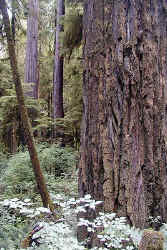
Jeremiah Smith Redwoods State Park - photo courtesy of the US
National Park Service |
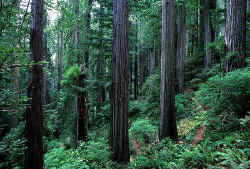
Prairie Creek Redwoods State Park - photo courtesy of the US
National Park Service. |
 Yosemite National
Park http://www.nps.gov/yose/
Yosemite National Park embraces a spectacular tract of mountain-and-valley scenery in the Sierra Nevada, which was set aside as a national park in 1890.
Highlights of the park include Yosemite Valley, and its high cliffs and waterfalls; the Mariposa Grove, which contains hundreds of ancient giant sequoias, the world's largest living things.; Glacier Point's (summer-fall) spectacular view of Yosemite Valley and the high country; and Tuolumne Meadows (summer-fall), a large subalpine meadow surrounded by mountain peak.
Massive and ancient giant sequoias live in three groves in Yosemite National Park. The most easily accessible of these (spring through fall) is the Mariposa Grove near the park's South Entrance, off of the Wawona Road (Highway 41). Two smaller--and less visited--groves are the Tuolumne and Merced Groves near Crane Flat. Yosemite National
Park http://www.nps.gov/yose/
Yosemite National Park embraces a spectacular tract of mountain-and-valley scenery in the Sierra Nevada, which was set aside as a national park in 1890.
Highlights of the park include Yosemite Valley, and its high cliffs and waterfalls; the Mariposa Grove, which contains hundreds of ancient giant sequoias, the world's largest living things.; Glacier Point's (summer-fall) spectacular view of Yosemite Valley and the high country; and Tuolumne Meadows (summer-fall), a large subalpine meadow surrounded by mountain peak.
Massive and ancient giant sequoias live in three groves in Yosemite National Park. The most easily accessible of these (spring through fall) is the Mariposa Grove near the park's South Entrance, off of the Wawona Road (Highway 41). Two smaller--and less visited--groves are the Tuolumne and Merced Groves near Crane Flat.
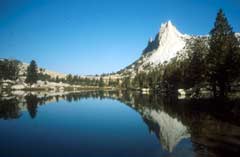
Yosemite National Park - photo by US National Park Service |
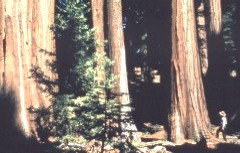
Sequoia National Park - photo by US National Park Service |
 Sequoia and Kings
Canyon National Parks http://www.nps.gov/seki/index.htm
These parks are home to giants: immense mountains, deep canyons, and huge trees. Thanks to their huge elevational range, 1,500' to 14,491', these parks protect stunningly diverse habitats. The Generals Highway climbs over 5000 feet from chaparral and oak-studded foothills to the awe-inspiring sequoia groves. From there, trails lead to the high-alpine wilderness which makes up most of these parks. Beneath the surface lie over 200 fascinating caverns. Grant Grove houses the General Grant Tree, which is the Nation's Christmas Tree and our only living national shrine, commemorating those Americans who lost their lives in war. The Lodgepole Visitor Center provides information for visitors to Giant Forest and the northern section of Sequoia National Park, our country's second oldest National Park. General Sherman Tree: The General Sherman Tree is 274.9' (83.8 meters) tall, and 102.6' (31.3 meters) in circumference at its base. Other trees in the world are taller: the tallest tree in the world is the Coast Redwood, which averages 300' - 350' (91.4 - 106.7 meters) in height. A cypress near Oaxaca, Mexico has a greater circumference, 162' (49.4 meters). But in volume of wood, the Sherman has no equal. With 52,500 cubic feet (1486.6 cubic meters) of wood, the General Sherman Tree earns the title of the World's Largest Living Thing. Sequoia and Kings
Canyon National Parks http://www.nps.gov/seki/index.htm
These parks are home to giants: immense mountains, deep canyons, and huge trees. Thanks to their huge elevational range, 1,500' to 14,491', these parks protect stunningly diverse habitats. The Generals Highway climbs over 5000 feet from chaparral and oak-studded foothills to the awe-inspiring sequoia groves. From there, trails lead to the high-alpine wilderness which makes up most of these parks. Beneath the surface lie over 200 fascinating caverns. Grant Grove houses the General Grant Tree, which is the Nation's Christmas Tree and our only living national shrine, commemorating those Americans who lost their lives in war. The Lodgepole Visitor Center provides information for visitors to Giant Forest and the northern section of Sequoia National Park, our country's second oldest National Park. General Sherman Tree: The General Sherman Tree is 274.9' (83.8 meters) tall, and 102.6' (31.3 meters) in circumference at its base. Other trees in the world are taller: the tallest tree in the world is the Coast Redwood, which averages 300' - 350' (91.4 - 106.7 meters) in height. A cypress near Oaxaca, Mexico has a greater circumference, 162' (49.4 meters). But in volume of wood, the Sherman has no equal. With 52,500 cubic feet (1486.6 cubic meters) of wood, the General Sherman Tree earns the title of the World's Largest Living Thing.

General Sherman Tree
 Joshua Tree
National Park http://www.nps.gov/jotr/
Two deserts, two large ecosystems whose characteristics are determined primarily by elevation, come together at Joshua Tree National Park. Below 3,000 feet, the Colorado Desert encompasses the eastern part of the park and features natural gardens of creosote bush, ocotillo, and cholla cactus. The higher, moister, and slightly cooler Mojave Desert is the special habitat of the Joshua tree. In addition to Joshua tree forests, the western part of the park also includes some of the most interesting geologic displays found in California’s deserts. Five fan palm oases also dot the park, indicating those few areas where water occurs naturally and wildlife abounds.
Joshua Tree
National Park http://www.nps.gov/jotr/
Two deserts, two large ecosystems whose characteristics are determined primarily by elevation, come together at Joshua Tree National Park. Below 3,000 feet, the Colorado Desert encompasses the eastern part of the park and features natural gardens of creosote bush, ocotillo, and cholla cactus. The higher, moister, and slightly cooler Mojave Desert is the special habitat of the Joshua tree. In addition to Joshua tree forests, the western part of the park also includes some of the most interesting geologic displays found in California’s deserts. Five fan palm oases also dot the park, indicating those few areas where water occurs naturally and wildlife abounds.
 Inyo National
Forest, US Forest Service http://www.fs.fed.us/r5/inyo/
Located in California's beautiful Eastern Sierra, the Inyo National Forest offers clean air, crystal blue skies, mountain lakes and streams, challenging trails, high mountain peaks, and beautiful views. With over two million acres, the Inyo National Forest is home to many natural wonders, including Mt. Whitney, Mono Lake, Mammoth Lakes Basin, and the Ancient Bristlecone Pine Forest, as well as seven Congressionally-designated Wildernesses, comprising over 650,000 acres of land. Inyo National
Forest, US Forest Service http://www.fs.fed.us/r5/inyo/
Located in California's beautiful Eastern Sierra, the Inyo National Forest offers clean air, crystal blue skies, mountain lakes and streams, challenging trails, high mountain peaks, and beautiful views. With over two million acres, the Inyo National Forest is home to many natural wonders, including Mt. Whitney, Mono Lake, Mammoth Lakes Basin, and the Ancient Bristlecone Pine Forest, as well as seven Congressionally-designated Wildernesses, comprising over 650,000 acres of land.
 GORP - Inyo
National Forest Page http://gorp.away.com/gorp/resource/us_national_forest/ca/see_iny1.htm
"Of the many scenic wonders found within the Inyo National Forest, one of the most amazing is the ANCIENT BRISTLECONE PINE FOREST, located between 10,000 and 11,000 ft. in the White Mountains, east of the Sierra Nevada. These trees
(Pinus longaeva) are the oldest known living trees on earth. Here in the White Mountains, the ancient trees have survived more than 40 centuries, exceeding the age of the oldest Giant Sequoia by 1,500 yrs."
GORP - Inyo
National Forest Page http://gorp.away.com/gorp/resource/us_national_forest/ca/see_iny1.htm
"Of the many scenic wonders found within the Inyo National Forest, one of the most amazing is the ANCIENT BRISTLECONE PINE FOREST, located between 10,000 and 11,000 ft. in the White Mountains, east of the Sierra Nevada. These trees
(Pinus longaeva) are the oldest known living trees on earth. Here in the White Mountains, the ancient trees have survived more than 40 centuries, exceeding the age of the oldest Giant Sequoia by 1,500 yrs."
 White
Mountains, Inyo National Forest, AMWest Travel http://www.amwest-travel.com/awt_bristle.html
In an obscure mountain range in eastern California the world's oldest living inhabitants, the bristlecone pines, have resided for
millenia. Ancient bristlecone pine forests exist in several western mountain ranges but the oldest trees live in California's White Mountains. The oldest living inhabitant of this earth, as far as is known, is a bristlecone pine named "Methuselah", dated by it tree rings to be a fantastic 4,770 years old (in 2004).
White
Mountains, Inyo National Forest, AMWest Travel http://www.amwest-travel.com/awt_bristle.html
In an obscure mountain range in eastern California the world's oldest living inhabitants, the bristlecone pines, have resided for
millenia. Ancient bristlecone pine forests exist in several western mountain ranges but the oldest trees live in California's White Mountains. The oldest living inhabitant of this earth, as far as is known, is a bristlecone pine named "Methuselah", dated by it tree rings to be a fantastic 4,770 years old (in 2004).
 Old Growth on the Middle Fork Ranger District
http://www.fs.fed.us/r6/willamette/forest/oldgrowth/
There are four basic forest types on the Middle Fork district,
Douglas-fir dominated (with some western hemlock and western redcedar),
mixed conifer (which contains Douglas-fir, grand fir, sugar pine,
incense cedar, and ponderosa pine), Pacific silver fir, and mountain
hemlock. These are general categories; all tree species often
occur as minor components in other types. A group of Forest
Service and university researchers developed a very specific definition
for Douglas- fir dominated old growth in 1986 with a publication
entitled “Interim Definitions for Old Growth Douglas-fir and Mixed
Conifer Forests in the Pacific Northwest and California”. This
publication indicates that an old- growth forest has at last eight trees
per acre larger than 32 inches in diameter, at least 12 trees per acre
greater than 16 inches in diameter of species such as western hemlock
and western redcedar which are tolerant of the shade produced by the
larger trees, more than four dead standing trees per acre greater than
20 inches in diameter and 15 feet tall, and more than four dead trees
per acre greater than 24 inches in diameter and 50 feet long lying on
the ground. On the Middle Fork District, stands with these
characteristics may take as long as 250 + years to develop. Old Growth on the Middle Fork Ranger District
http://www.fs.fed.us/r6/willamette/forest/oldgrowth/
There are four basic forest types on the Middle Fork district,
Douglas-fir dominated (with some western hemlock and western redcedar),
mixed conifer (which contains Douglas-fir, grand fir, sugar pine,
incense cedar, and ponderosa pine), Pacific silver fir, and mountain
hemlock. These are general categories; all tree species often
occur as minor components in other types. A group of Forest
Service and university researchers developed a very specific definition
for Douglas- fir dominated old growth in 1986 with a publication
entitled “Interim Definitions for Old Growth Douglas-fir and Mixed
Conifer Forests in the Pacific Northwest and California”. This
publication indicates that an old- growth forest has at last eight trees
per acre larger than 32 inches in diameter, at least 12 trees per acre
greater than 16 inches in diameter of species such as western hemlock
and western redcedar which are tolerant of the shade produced by the
larger trees, more than four dead standing trees per acre greater than
20 inches in diameter and 15 feet tall, and more than four dead trees
per acre greater than 24 inches in diameter and 50 feet long lying on
the ground. On the Middle Fork District, stands with these
characteristics may take as long as 250 + years to develop.
 Friends
of Gualala River http://www.gualalariver.org/forestry/haupt.html
Logging Old Growth on the Haupt Creek. After denying a plan
to log 44 acres of old growth forest for lack of required environmental
information (see below), the Department of Forestry (CDF) exempted 890
acres of old growth from environmental review to permit logging of
"dead, dying and diseased" trees. The landowner
submitted an application for an exemption on June 22, 2004. CDF
responded the next day that they had accepted the exemption, and
assigned it exemption number 1-04EX-237-SON. Friends of the
Gualala River (FoGR) is concerned that this unregulated logging activity
in an old growth redwood forest -- the last major stand of its type in
Sonoma County -- will have serious adverse environmental impacts. Friends
of Gualala River http://www.gualalariver.org/forestry/haupt.html
Logging Old Growth on the Haupt Creek. After denying a plan
to log 44 acres of old growth forest for lack of required environmental
information (see below), the Department of Forestry (CDF) exempted 890
acres of old growth from environmental review to permit logging of
"dead, dying and diseased" trees. The landowner
submitted an application for an exemption on June 22, 2004. CDF
responded the next day that they had accepted the exemption, and
assigned it exemption number 1-04EX-237-SON. Friends of the
Gualala River (FoGR) is concerned that this unregulated logging activity
in an old growth redwood forest -- the last major stand of its type in
Sonoma County -- will have serious adverse environmental impacts.
 Sierra Nevada
Forest Protection Campaign http://www.sierracampaign.org/
http://www.sierracampaign.org/OldGrowth.html
The Sierra Nevada Forest Protection Campaign is a coalition of conservation organizations, individual activists, scientists, businesses and spiritual leaders fighting for the protection of old growth forests, sensitive watersheds and threatened wildlife in the Sierra Nevada mountain range. Sierra Nevada
Forest Protection Campaign http://www.sierracampaign.org/
http://www.sierracampaign.org/OldGrowth.html
The Sierra Nevada Forest Protection Campaign is a coalition of conservation organizations, individual activists, scientists, businesses and spiritual leaders fighting for the protection of old growth forests, sensitive watersheds and threatened wildlife in the Sierra Nevada mountain range.
 California Wild
Heritage Campaign http://www.californiawild.org/
The California Wild Heritage Campaign is a broad based coalition with only one goal - to preserve California's unprotected wilderness and wild rivers for future generations to enjoy. To achieve this goal, we need your help! Read on to find out how you can help save the last wild places in California. California Wild
Heritage Campaign http://www.californiawild.org/
The California Wild Heritage Campaign is a broad based coalition with only one goal - to preserve California's unprotected wilderness and wild rivers for future generations to enjoy. To achieve this goal, we need your help! Read on to find out how you can help save the last wild places in California.
 GORP - California
Wilderness http://gorp.away.com/gorp/resource/us_wilderness_area/az.htm
Green forests and tumbling rivers; small mountain lakes tucked behind towering peaks; desert vistas stretching as far as the eye can see. These scenes and a multitude of other sights greet visitors to the Areas of California. GORP - California
Wilderness http://gorp.away.com/gorp/resource/us_wilderness_area/az.htm
Green forests and tumbling rivers; small mountain lakes tucked behind towering peaks; desert vistas stretching as far as the eye can see. These scenes and a multitude of other sights greet visitors to the Areas of California.
 Gynosperms of Alta California http://www.botanik.uni-bonn.de/conifers/topics/caltrees.htm Gynosperms of Alta California http://www.botanik.uni-bonn.de/conifers/topics/caltrees.htm
 Redwood Hikes A guide to California's old-growth coast redwood trails
http://www.redwoodhikes.com:80/
Redwood Hikes A guide to California's old-growth coast redwood trails
http://www.redwoodhikes.com:80/
|